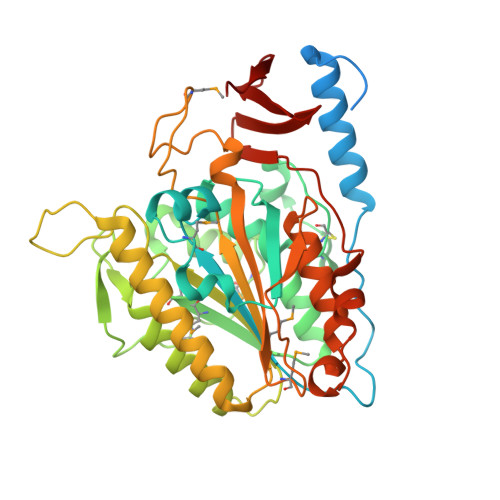TheEscherichia colicellulose synthase subunit G (BcsG) is a Zn2+-dependent phosphoethanolamine transferase.
Anderson, A.C., Burnett, A.J.N., Hiscock, L., Maly, K.E., Weadge, J.T.(2020) J Biological Chem 295: 6225-6235
- PubMed: 32152228
- DOI: https://doi.org/10.1074/jbc.RA119.011668
- Primary Citation of Related Structures:
6PCZ, 6PD0 - PubMed Abstract:
Bacterial biofilms are cellular communities that produce an adherent matrix. Exopolysaccharides are key structural components of this matrix and are required for the assembly and architecture of biofilms produced by a wide variety of microorganisms. The human bacterial pathogens Escherichia coli and Salmonella enterica produce a biofilm matrix composed primarily of the exopolysaccharide phosphoethanolamine (pEtN) cellulose. Once thought to be composed of only underivatized cellulose, the pEtN modification present in these matrices has been implicated in the overall architecture and integrity of the biofilm. However, an understanding of the mechanism underlying pEtN derivatization of the cellulose exopolysaccharide remains elusive. The bacterial cellulose synthase subunit G (BcsG) is a predicted inner membrane-localized metalloenzyme that has been proposed to catalyze the transfer of the pEtN group from membrane phospholipids to cellulose. Here we present evidence that the C-terminal domain of BcsG from E. coli ( Ec BcsG ΔN ) functions as a phosphoethanolamine transferase in vitro with substrate preference for cellulosic materials. Structural characterization of Ec BcsG ΔN revealed that it belongs to the alkaline phosphatase superfamily, contains a Zn 2+ ion at its active center, and is structurally similar to characterized enzymes that confer colistin resistance in Gram-negative bacteria. Informed by our structural studies, we present a functional complementation experiment in E. coli AR3110, indicating that the activity of the BcsG C-terminal domain is essential for integrity of the pellicular biofilm. Furthermore, our results established a similar but distinct active-site architecture and catalytic mechanism shared between BcsG and the colistin resistance enzymes.
- Department of Biology, Wilfrid Laurier University, Waterloo, Ontario N2L 3C5, Canada.
Organizational Affiliation:



















